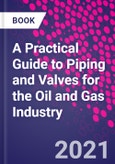A Practical Guide to Piping and Valves for the Oil and Gas Industry covers how to select, test and maintain the right oil and gas valve. Each chapter focuses on a specific type of valve with a built-in structured table on valve selection. Covering both onshore and offshore projects, the book also gives an introduction to the most common types of corrosion in the oil and gas industry, including CO2, H2S, pitting, crevice, and more. A model to evaluate CO2 corrosion rate on carbon steel piping is introduced, along with discussions on bulk piping components, including fittings, gaskets, piping and flanges.
Rounding out with chapters devoted to valve preservation to protect against harmful environments and factory acceptance testing, this book gives engineers and managers a much-needed tool to better understand today's valve technology.
Please Note: This is an On Demand product, delivery may take up to 11 working days after payment has been received.
Table of Contents
1. Ball Valves Applications and Design 2. Butterfly Valves Applications and Design 3. Plug Valves Application and Design 4. Through Conduit Gate Valves Applications and Design 5. Modular Valves Applications and Design 6. Wedge Gate Valves Applications and Design 7. Globe Valve Applications and Design 8. Piston Check Valves 9. Dual Plate Check Valves 10.�Non Slam�Check Valves 11. Pipeline Valves 12. Valve Technology and Selection 13. Piping and Valve Corrosion Study 14. Bulk Piping Items 15. Piping and Valve Material Selection in Offshore 16. Piping Special Items 17. Valve Actuation 18. Valves Preservation and Packing Requirements 19. Valve Gear Box Considerations 20. Factory Acceptance Test








